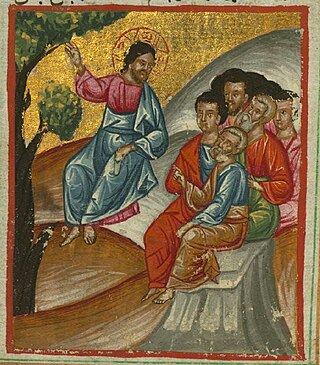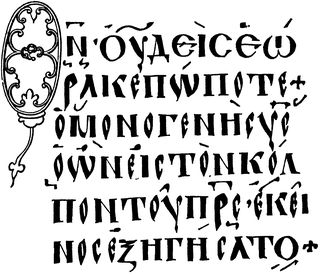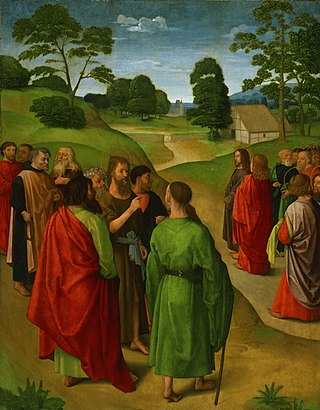
Matthew 5:1 and Matthew 5:2 are the first two verses of the fifth chapter of the Gospel of Matthew in the New Testament. The verses introduce the Sermon on the Mount that will be recited in the next several chapters. The previous chapter concluded with large crowds "from Galilee, and from the Decapolis, Jerusalem, Judea, and beyond the Jordan" who followed Jesus to witness him healing: these verses present Jesus as seeing the crowds and going up onto a mountain to begin teaching.
Matthew 10:40 is a verse in the tenth chapter of the Gospel of Matthew in the New Testament.
Matthew 9:10 is a verse in the ninth chapter of the Gospel of Matthew in the New Testament.
Matthew 11:1 is the first verse in the eleventh chapter of the Gospel of Matthew in the New Testament.

Matthew 12:1 is the first verse in the twelfth chapter of the Gospel of Matthew in the New Testament of the Christian Bible.
Matthew 12:48 is the 48th verse in the twelfth chapter of the Gospel of Matthew in the New Testament.

Matthew 8:20 is the 20th verse in the eighth chapter of the Gospel of Matthew in the New Testament of the Christian Bible. It reveals the homelessness of Jesus and his followers.

Matthew 10:32 is the 32nd verse in the ninth chapter of the Gospel of Matthew in the New Testament.
Matthew 12:28 is the 28th verse in the twelfth chapter of the Gospel of Matthew in the New Testament.

The calling of the disciples is a key episode in the life of Jesus in the New Testament. It appears in Matthew 4:18–22, Mark 1:16-20 and Luke 5:1–11 on the Sea of Galilee. John 1:35–51 reports the first encounter with two of the disciples a little earlier in the presence of John the Baptist. Particularly in the Gospel of Mark, the beginning of the Ministry of Jesus and the call of the first disciples are inseparable.

John 1:16 is the sixteenth verse in the first chapter of the Gospel of John in the New Testament of the Christian Bible.

John 1:19 is the nineteenth verse in the first chapter of the Gospel of John in the New Testament of the Christian Bible.

John 1:36 is the 36th verse in the first chapter of the Gospel of John in the New Testament of the Christian Bible.

John 1:37 is the 37th verse in the first chapter of the Gospel of John in the New Testament of the Christian Bible.

John 1:38 is the 38th verse in the first chapter of the Gospel of John in the New Testament of the Christian Bible.

John 1:40 is the 40th verse in the first chapter of the Gospel of John in the New Testament of the Christian Bible. It states that Andrew was a disciple of John the Baptist.

John 1:43 is the 43rd verse in the first chapter of the Gospel of John in the New Testament of the Christian Bible.

John 1:45 is the 45th verse in the first chapter of the Gospel of John in the New Testament of the Christian Bible.
Matthew 11:4-6 is a set of verses in the eleventh chapter of the Gospel of Matthew in the New Testament.

This narrative is told in Luke 5:1-3, Mark 4:1, and Matthew 13:1-3. Owing to the vast crowds that followed him from the surrounding towns and villages to listen to his doctrine, Jesus retired to the sea coast. There he entered a boat, that he used as a pulpit, and addressed the crowd on the shore.














